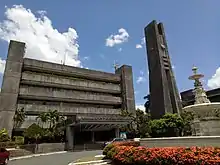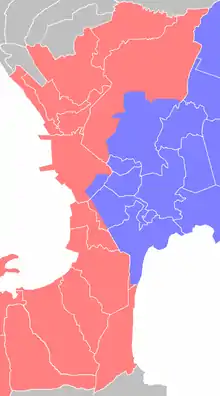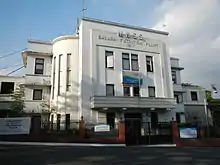Metropolitan Waterworks and Sewerage System
The Metropolitan Waterworks and Sewerage System (Tagalog: Pangasiwaan ng Tubig at Alkantarilya sa Kalakhang Maynila), formerly known as the National Waterworks and Sewerage System Authority (NAWASA), is the government agency that is in charge of water privatization in Metro Manila in the Philippines.[1] It split the water concession into an east and a west concession with Manila Water being awarded one contract and Maynilad Water Services being awarded the other.
| Pangasiwaan ng Tubig at Alkantarilya sa Kalakhang Maynila MWSS | |
.svg.png.webp) | |
 MWSS Headquarters | |
| Agency overview | |
|---|---|
| Formed | June 19, 1971 |
| Preceding agencies |
|
| Headquarters | Katipunan Avenue, Balara, Diliman, Quezon City, Philippines |
| Agency executive |
|
| Parent department | Department of Public Works and Highways |
| Website | mwss |


History
The first water system in the Philippines was initiated by the Spanish Philanthropist, Francisco Carriedo y Peredo[2] (November 7, 1690 - September 1743). Carriedo donated funds to be used in Manila; however, it was never realized until a century later, when the Spanish Franciscan friar Felix Huerta[3], tracked down the funds donated by Carriedo, and instigated the development of the Carriedo Water System. The construction of the water system delivered 16 million liters of water per day to 300,000 people. By 1909, the capacity of the system was increased to 92 million liters per day by the addition of pumping facilities and the construction of Wawa Dam.
With its expansion of responsibilities, the institution changed its name several times from the Carriedo Water System, to the Manila Water Supply System in 1908, to the Metropolitan Water District in 1919, to the National Waterworks and Sewerage System Authority (Pangasiwaan ng Pambansang Tubig at Alkantarilya), and finally, to the Metropolitan Waterworks and Sewerage System (MWSS) in 1971.
Former Directors
- 1930-1934: Paul W. Mack
- 1934-1938: Gregorio Anonas
- 1938-1947: Ambrosio Magsaysay
- 1947-1955: Manuel Mañosa
- 1955-1963: Susano R. Nagado
- 1963-1966: Jesus C. Perlas
- 1966-1969: Antonio C. Menor
- 1969-1976: Sergio M. Isada
- 1976-1983: Oscar J. Ilustre
- 1983-1986: Abor P. Canlas
- 1986-1987: Jose Yap
- 1987-1992: Luis V. Sison
- 1992-1994: Teofilo J. Asuncion
- 1994-1995 Ruben A. Hernandez
- 1995-1997: Dr. Angel L. Lazaro III
- 1997-2000: Dr. Reynaldo B. Vea
- 2000-2001: Jose F. Mabanta
- 2001-2006: Orlando C. Hondrade
- 2007-2008: Lorenzo H. Jamora
- 2008-2010: Diosdado Jose M. Allado
Metropolitan Waterworks and Sewerage System Regulatory Office
The MWSS Regulatory Office (RO) was created in August 1997 by virtue of the Concession Agreements signed between the MWSS and the two concessionaires, Manila Water Company, Inc.[4] for the East Zone and Maynilad Water Services, Inc. for the West Zone.
RO functions as a collegial body composed of five members headed by the Director or Chief Regulator who has over-all responsibility for the operation of the office. Other members are the Regulators for Technical Regulation, Customer Service Regulation, Financial Regulation and Administration and Legal Affairs.
Any action or decision by the RO on substantive matters affecting the Concession Agreement requires at least a majority vote of three members. The Chief Regulator chairs the meeting of the Regulatory Office and has the final approval over the hiring and dismissal of all professional staff of the RO. He also acts as the principal spokesperson of the office.
RO is mandated to monitor the Concession Agreement. Among its many functions, RO reviews, monitor and enforces rates and service standards; arranges and reports regular independent audits of the performance of the Concessionaires; and monitors the infrastructure assets. However, RO’s functions may change over time for effective regulation of water and sewerage services.
Private Concessionaires
References
- Dumol, Mark (2000). The Manila Water Concession: A Key Government Official's Diary of the World's Largest Water Privatization. United States of America: The World Bank. ISBN 0-8213-4711-X.
- http://withonespast.com/2014/01/07/don-francisco-carriedo-and-manilas-first-water-system/
- https://www.gmanetwork.com/news/news/ulatfilipino/303736/sino-si-felix-huerta-at-bakit-ipinangalan-sa-kanya-ang-isang-kalye-sa-sta-cruz-area/story/a
- https://ppp.worldbank.org/public-private-partnership/sites/ppp.worldbank.org/files/documents/ManilaWater_ConcessionAgreement_EN.pdf
- Metropolitan Waterworks and Sewerage System. "Our Concessionaires". Metropolitan Waterworks and Sewerage System. Retrieved September 26, 2016.
External links
| Wikimedia Commons has media related to Metropolitan Waterworks and Sewerage System. |